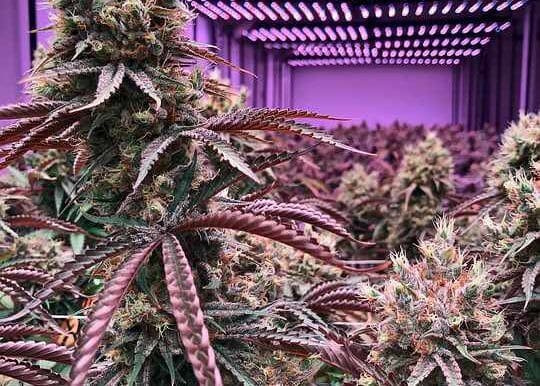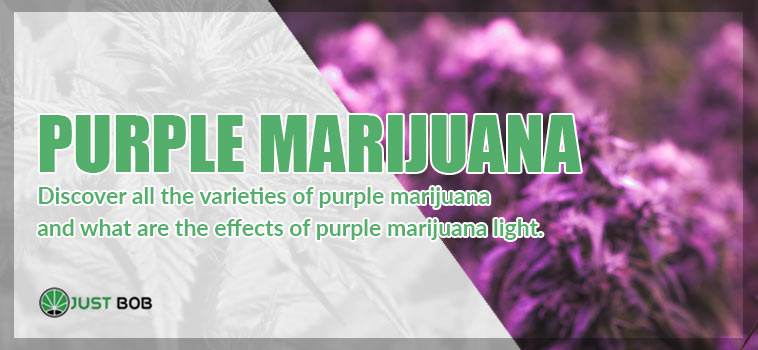Modified on: 18/01/2024
DISCOVER ALL THE VARIETIES OF PURPLE CANNABIS STRAINS AND WHAT ARE THE EFFECTS OF PURPLE CBD MARIJUANA
In the Hindu Kush region, between Afghanistan and Pakistan (famous for hashish production), a large amount of wild mountain marijuana grows free: the same CBD cannabis that we also find legally in our cities, when it is controlled and has a low quantity of THC.
CBD weed is developing more and more interest, gaining admirers, consumers and curious onlookers every day.
In an attempt to learn about every possible variety of this plant with extraordinary properties, many wonder about its most particular, most sought after aspects, green ones such as Purple Marijuana.
Yes, the same one to which a certain Jimi Hendrix ended up dedicating the title of one of his famous pieces.
But what are we exactly talking about? What is the difference between Purple and normal Cannabis?

Exploring the Enigma of Purple Cannabis
Purple cannabis has captivated cannabis enthusiasts with its stunning appearance and unique characteristics. This distinct variety of cannabis, characterized by its purple hues, has gained popularity for both its aesthetic appeal and potential therapeutic properties. In this article, we will delve into the world of purple cannabis, exploring its origins, genetic makeup, and the factors that contribute to its vibrant coloration.
Understanding Purple flowers:
Purple cannabis refers to a specific category of cannabis strains that exhibit various shades of purple in their flowers and buds. These strains are often referred to as the purple strain weed, weed strains or purple strains, and they stand out for their deep purple, violet, or lavender coloration. This color variation is attributed to the presence of anthocyanin pigments, which are responsible for the purple, blue, and red colors observed in many plants.
Genetic Influences:
The genetic makeup of purple cannabis strains plays a crucial role in their color expression. Strains like Purple Kush, Purple Haze, Purple Urkle, and Purple Afghani are examples of popular purple cannabis flower varieties. These strains carry specific purple genetics that contribute to the deep purple hue seen in their flowers and buds.
Environmental Factors:
The color transformation of cannabis plants into shades of purple turn pink occurs during the flowering stage. Low temperatures, especially during the cool weather of autumn, trigger the accumulation of anthocyanin pigments, turning the plant purple. The process is similar to how deciduous trees display vibrant colors in the fall.
Medical Cannabis and Therapeutic Potential:
While the coloration of purple cannabis buds is visually striking, it’s essential to note that the color itself doesn’t determine the therapeutic properties. Purple cannabis strains, like any other cannabis variety, may contain varying levels of cannabinoids, terpenes, and other active compounds. Medical cannabis users appreciate the potential benefits of these compounds, which may include pain relief, relaxation, and anti-inflammatory effects.
Popular purple weed strains:
Some well-known purple cannabis strains include Grape Ape, Mendocino Purps, and Granddaddy Purple. Each purple strain also boasts its unique terpene profile, cannabinoid content, and overall effects. Granddaddy Purple, for instance, is celebrated for its calming and sedative properties, making it a favorite among those seeking relaxation.
Purple cannabis stands as a visually captivating and widely appreciated variation in the diverse world of cannabis. The interplay of genetics and environmental factors, such as low temperatures, contributes to the development of these unique strains. Whether grown for medical purposes or recreational enjoyment, purple cannabis continues to intrigue and delight cannabis enthusiasts around the world with its alluring shades of purple.
>> Read also: Marijuana herbal tea: this is how to prepare an excellent infusion
How to grow Purple weed strain?
Once the choice of the type bud color of plant has been made, it is necessary to know which are the parameters to be taken into account to increase the typical purple color characteristics.
They are the temperatures that play a decisive role, influencing the expressed nuances. If some types of plants show their purple essence regardless, others need a certain temperatures to show themselves.
In some cases, even the difference between day and night temperature makes the difference.
It takes between 8 and 10 weeks or so to gather the fruits of our cultivation work, whether it is born indoors or outdoors, but it is where the climate is particularly temperate or warm that we see an increase in the quality of the Purple.
The objective therefore is to subject the crops to temperature changes according to the time of day: warmer in the morning, colder at night; it is a winning strategy to stimulate the chromatic variation of the plant.
Lights play a key role in the photosynthesis process, only thanks to them the plants produce the energy they need for their development.
An intense, powerful and direct green light source would seem to stimulate the purple color we are talking about.
Another reason why the tops of your plants can take on blue colors and the peculiar color of violets is due to the anthocyanins, a class of water-soluble pigments, about 400, which can be of different colors, depending on the pH.
In the case of almost neutral pH, the cannabis varieties containing these pigments tend to be green varieties show purple shades at the top.
These pigments do not show up until the last weeks of the plant’s life, due to the lower flow of chlorophyll in the plant parts.
When the plants are only two weeks away to complete the flowering phase, the temperature of the cultivation room must be changed to keep it below 10° C, but above 4° C.
Most varieties require cold temperatures to best express the color potential.
This is a feature that is still unclear, but there is a connection that largely explains the process.
Although almost all varieties of marijuana plants are able to withstand cold environmental conditions, one must try not to lower the temperature suddenly, but gradually, so as not to stress the plant.
Do you know synthetic cannabis? Find out why avoid it by reading the following article: “Synthetic marijuana alarm, a very dangerous drug“.
What are the effects of the legal Purple Cannabis?
With a very intense flavor, the CBD Purple seems to show the same typical effects on the body and on the psyche of legal weed UK consumers.
A sense of euphoria, of lightness, which can be of great help in cushioning daily stress or different non-invasive diseases such as headaches, panic attacks or depressive states.
Also in the Purple we find a strong anti-emetic property, which is not defeats nausea, but helps develop a sense of appetite.
The use of the Purple at night is highly recommended, for those who, for various reasons, suffer from sleep disorders or a real state of continuous insomnia. An alternative solution to those issues can be CBD oil too.
The Purple relaxes, relaxes the nerves and gives its consumer a great help in finally finding a peaceful and regular sleep.
Is purple punch a sativa or indica?
Purple Punch is an indica-dominant cannabis strain known for its deep purple hues. This strain is a result of the crossbreeding of Larry OG with Granddaddy Purple, bringing together purple cannabis genetics. During the flowering stage, the plant can turn purple due to the presence of anthocyanin pigments. These pigments, responsible for purple coloration in cannabis strains, accumulate when temperatures drop, especially during cool weather.
Purple Punch is part of the purple weed strains category and is appreciated for its relaxing effects. The purple cannabis flowers exhibit various shades of the purple pigment, and the buds carry a distinctive purple color. While purple strains, in general, showcase purple pigments, each strain may have its unique combination of cannabinoids, terpene profiles, and THC levels.
In the case of Purple Punch, it is recognized for its higher THC content and is commonly associated with alleviating chronic pain. The strain’s cannabinoid production and overall anthocyanin content contribute to its purple appearance. It’s important to note that Purple Punch falls into the indica category, making it known for its relaxing properties rather than energizing effects typically associated with sativa strains.
In summary, Purple Punch is an indica-dominant purple cannabis strain celebrated for its deep purple hues, relaxing effects, and higher THC content.
What’s Purple Kush?
Purple Kush, a mesmerizing strain within the realm of cannabis, has captivated enthusiasts worldwide with its deep purple hues and distinct properties. In this article, we’ll unravel the mysteries surrounding Purple Kush, delving into its genetic makeup, unique characteristics, and the factors that contribute to its renowned purple appearance.
Purple Kush and its Purple Cannabis Origins:
Purple Kush belongs to the family of purple cannabis strains, characterized by the stunning violet green or deep purple colors exhibited by the flowers and buds during the flowering stage. Its lineage can be traced to the potent crossbreeding of different cannabis strains, with influences from varieties like Purple Afghani and Purple Urkle.
The Allure of Deep Purple Hue:
The signature deep purple hue of Purple Kush is a result of anthocyanin pigments, which are compounds that accumulate in the cannabis plant during the flowering stage. These pigments react to low temperatures, causing the plant to turn purple. The presence of anthocyanins distinguishes Purple Kush from other strains, contributing to its unique visual appeal.
Cannabis Genetics and Purple Kush:
Purple Kush carries specific purple genetics that make it stand out in the world of marijuana strains. The interplay of these genetic factors, along with environmental conditions, results in the expression of the deep purple colors for which this strain is widely appreciated.
Environmental Factors and Purple Expression:
Environmental factors play a crucial role in the manifestation of Purple Kush’s distinctive coloration. Low temperatures trigger the accumulation of anthocyanins, leading the plant to turn purple. This phenomenon is particularly evident in varieties like Purple Kush, where the deep purple shades are a testament to the interplay between genetics and environmental conditions.
Medical Cannabis and Purple Kush:
Beyond its visual appeal, Purple Kush is recognized for its therapeutic properties. It falls within the category of medical cannabis strains, offering relief from chronic pain and delivering a calming and sedative effect. The strain’s cannabinoid content, including higher levels of active compounds, contributes to its medicinal value.
In the diverse world of cannabis strains, Purple Kush stands as a testament to the beauty of genetic diversity and environmental influence. Its deep purple hues, unique genetic makeup, and therapeutic properties make it a widely appreciated and sought-after strain among enthusiasts. Whether for its visual allure or medicinal benefits, Purple Kush continues to leave an indelible mark in the ever-evolving landscape of cannabis culture.
Is purple Kush psychedelic?
Purple Kush is not typically considered psychedelic. While it is a purple cannabis strain known for its deep purple hues and relaxing effects, the term “psychedelic” is more commonly associated with certain sativa strains or other substances that induce hallucinations and altered states of consciousness.
Purple Kush is an indica-dominant strain with purple flowers and purple buds throughout, and it is part of the category of purple weed strains. The strain is appreciated for its calming and sedative properties rather than producing psychedelic experiences. The deep purple coloration of Purple Kush is attributed to the presence of anthocyanin pigments, which accumulate during the flowering stage, especially when temperatures drop.
In summary, Purple Kush is not classified as psychedelic; instead, it is recognized for its relaxing effects and distinctive purple appearance!





